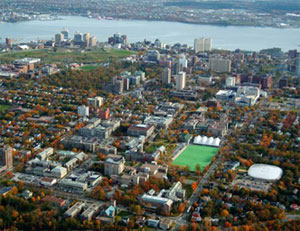 |
| Aerial photo of Dal's Studley campus. To see more aerial photos, click here. |
Dalhousie has begun a campus planning process to provide clear direction for the university’s physical development for years to come.
“The university needs a clear, concise version of how the campus should grow to align with Dalhousie’s strategic goals,” says Jeff Lamb, assistant vice-president of Facilities Management.
Dalhousie’s last campus plan, A Collective Vision, was designed in 1991. Many of the assumptions made in that plan are no longer valid.
The plan put most parking underground and called for the development of a “house form,” or smaller scale structures as the preferred style of building. The parking recommendation has run into problems because of the huge cost of drilling into bedrock. The “house form” turned out to be impractical, as it did not take into account heating and maintenance costs or the need for large classrooms.
There was also a lack of public acceptance for the 1991 plan, says Mr. Lamb, and it was developed before the Technical University of Nova Scotia (TUNS) and Dalhousie amalgamated. A campus plan has never been completed for Sexton Campus.
President Tom Traves says this new campus planning initiative is of great importance and connects the university’s strategic goals—these include enhanced academic and research excellence, an enriched student experience, an increase in enrolment, the development of excellent human resources, the advancement of fund-raising support and financial stability—to concrete needs.
“If you break them down, most of the strategic goals translate at least in part into space needs,” says Dr. Traves. “For example, research means more space for labs and an enriched student experience means more space for students. This planning process is a major way to achieve those goals.”
“Facilities are the biggest asset owned by Dal,” says Mr. Lamb, “they need to be used effectively and aligned with academic plans. A campus plan that identifies priorities for maintenance and new construction is also vital to ensure that future facilities renewal funds are spent wisely.”
One of the tough issues that must be dealt with in developing a master plan is the issue of deferred maintenance—estimated at more than $200 million. It’s recommended the university spend an additional $1 million a year tackling that backlog, but that doesn’t make a dent in it. Lamb estimates it would take over $20 million a year to catch up.
How Dalhousie can align those priorities in a master campus plan will begin with the hiring of a consulting team. That will take place over the next several months. There’s also a steering committee to guide the process and a planning team. Public consultation will be carried out with internal and external audiences, including students, faculty, staff and neighbours.
Once consultants are in place, research will be carried out on academic programming and facilities as they link to the future needs. Dalhousie’s real estate holdings will be assessed. Purchase and sale opportunities will be examined. Zoning or other land use planning changes will be analyzed.
The planning process will also examine campus landscaping. How can roadways and pathways be improved so the campus is more connected? Everything will come under scrutiny, from bike racks, lighting and outdoor furniture to trees, shrubs and flowers.
In a nutshell, the analyses of current facilities fall under several broad categories:
- an inventory of all the current space
- real capital asset planning
- classroom use
- campus land use and zoning
- transportation and parking
- utilities
Once the data is compiled, a priority list will be drawn up. It will include action and implementation strategies, and design guidelines. Environmental sustainability will play a big role. Everything built on campus will have to be LEED-designed and certified. (LEED stands for Leadership in Energy and Environmental Design. It’s a rating system. Points are earned for aspects of a building that are environmentally friendly.)
Mr. Lamb says the hope is to have a draft ready for review by next winter and a master campus plan in place by fall 2009.
“We do not need a plan with lots of beautiful photographs and multi-coloured graphs that ends up on a bookshelf and has the dust blown off it once in awhile,” says Mr. Lamb. “We need a master plan that works for us. To get there, an honest, reasoned effort is required.”
